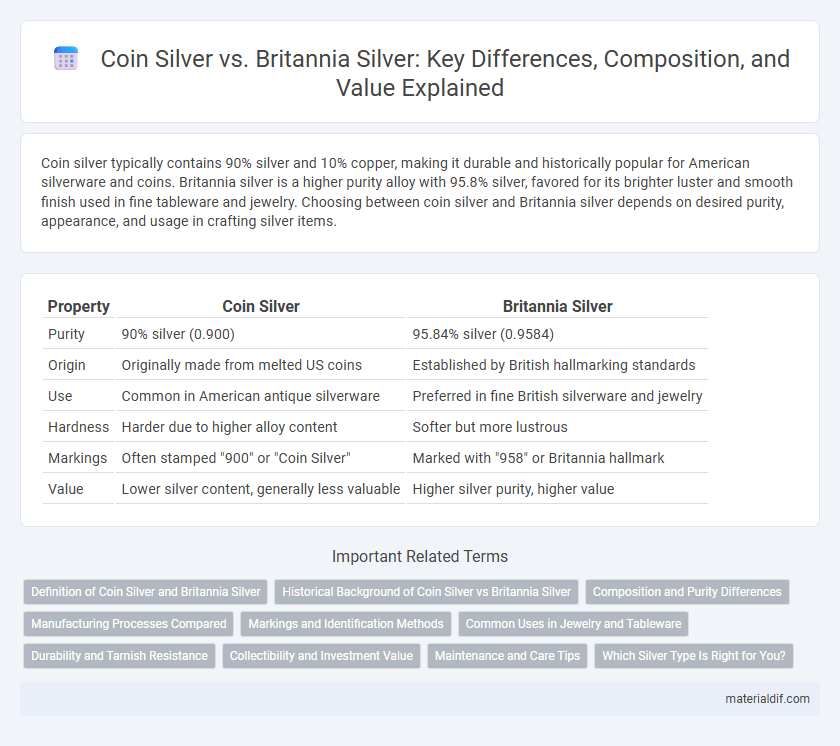Coin silver typically contains 90% silver and 10% copper, making it durable and historically popular for American silverware and coins. Britannia silver is a higher purity alloy with 95.8% silver, favored for its brighter luster and smooth finish used in fine tableware and jewelry. Choosing between coin silver and Britannia silver depends on desired purity, appearance, and usage in crafting silver items.
Table of Comparison
| Property | Coin Silver | Britannia Silver |
|---|---|---|
| Purity | 90% silver (0.900) | 95.84% silver (0.9584) |
| Origin | Originally made from melted US coins | Established by British hallmarking standards |
| Use | Common in American antique silverware | Preferred in fine British silverware and jewelry |
| Hardness | Harder due to higher alloy content | Softer but more lustrous |
| Markings | Often stamped "900" or "Coin Silver" | Marked with "958" or Britannia hallmark |
| Value | Lower silver content, generally less valuable | Higher silver purity, higher value |
Definition of Coin Silver and Britannia Silver
Coin silver typically refers to silver that contains approximately 90% pure silver, originally derived from melted-down silver coins, while Britannia silver has a higher purity standard of 95.8% silver, established in England in 1697 to ensure superior quality. Coin silver's hallmark is often 0.900 fineness, whereas Britannia silver is marked as 0.958 fineness. These differing purity levels impact the durability, value, and use of the silver in jewelry and tableware.
Historical Background of Coin Silver vs Britannia Silver
Coin silver, traditionally composed of 90% silver and 10% copper, originated in the United States during the 19th century as a practical standard using melted-down coins for various silverware. Britannia silver, established in England in 1697, features a higher purity of 95.8% silver, mandated to distinguish it from sterling silver and discourage the melting of currency for tableware. The historical divergence reflects differing national priorities: American pragmatism in recycling coins versus British regulatory efforts to protect currency integrity while promoting high-quality silver products.
Composition and Purity Differences
Coin Silver typically consists of 90% silver and 10% copper, reflecting its origins as recycled U.S. coins, while Britannia Silver boasts a higher purity of 95.8% silver with minimal alloy metals for enhanced whiteness and durability. The marked difference in silver content affects both the metal's hardness and its suitability for fine silverware, with Britannia Silver preferred for luxury items due to its superior purity. This compositional variance aligns with hallmark standards, where Coin Silver shows a lower purity hallmark than the 958 Britannia Silver mark recognized in the UK.
Manufacturing Processes Compared
Coin silver, traditionally composed of 90% silver and 10% copper, undergoes a simpler manufacturing process involving melting and casting recycled coins, resulting in a durable but less pure alloy. Britannia silver, stamped with a higher purity of 95.8%, requires a more refined refining process that eliminates more impurities and involves precise alloying techniques for enhanced brightness and resistance to tarnish. The manufacturing processes of Britannia silver demand stricter quality control measures and often utilize advanced techniques such as electroplating or rolling to achieve its characteristic smooth finish and consistent purity.
Markings and Identification Methods
Coin Silver typically contains 90% silver content and is marked with "925" or "900" along with stamps like "Coin" or "Sterling," while Britannia Silver boasts a higher purity of 95.8% and is usually marked with "958" or the Britannia symbol for easy identification. Identification methods rely on examining hallmarks, assay office stamps, and standardized purity numbers to differentiate Coin Silver from Britannia Silver accurately.
Common Uses in Jewelry and Tableware
Coin silver, typically containing 90% silver and 10% copper, is favored for crafting durable, affordable jewelry and vintage-style tableware, offering a classic yet functional aesthetic. Britannia silver, with a higher purity of 95.8% silver, is preferred for fine jewelry and high-quality tableware, prized for its bright luster and resistance to tarnish. Both types balance durability and beauty, but Britannia silver remains the standard for luxury items requiring superior shine and finesse.
Durability and Tarnish Resistance
Coin silver, composed of approximately 90% silver and 10% copper, offers moderate durability but is more prone to tarnishing due to its higher copper content. Britannia silver, with a higher purity of 95.8% silver, tends to be softer but demonstrates better tarnish resistance because of its refined composition. For applications requiring a balance of durability and reduced tarnishing, coin silver is often preferred, while britannia silver suits decorative pieces valuing luster and resistance.
Collectibility and Investment Value
Coin Silver, typically 90% pure, offers historical appeal due to its use in early American currency, making it highly collectible for antique enthusiasts. Britannia Silver, with a higher purity of 95.8%, appeals more to investors prioritizing intrinsic silver content and standardized quality. While Coin Silver holds niche rarity value, Britannia Silver provides stronger liquidity and consistent market demand for investment purposes.
Maintenance and Care Tips
Coin silver, typically 90% pure silver, requires regular polishing to prevent tarnish and should be cleaned using mild soap and a soft cloth to maintain its luster. Britannia silver, with a higher purity of 95.8%, is softer and more prone to scratches, so gentle handling and avoiding abrasive materials are essential for its care. Storing both types in anti-tarnish cloth or airtight containers significantly reduces oxidation and prolongs their shine.
Which Silver Type Is Right for You?
Coin silver typically contains 90% silver and 10% copper, offering durability and a historic charm ideal for everyday use and antique enthusiasts. Britannia silver has a higher purity level at 95.8%, making it softer but more lustrous, preferred for fine silverware and collectors seeking quality and elegance. Choose coin silver for robust, vintage appeal or Britannia silver for refined, high-quality craftsmanship.
Coin Silver vs Britannia Silver Infographic

 materialdif.com
materialdif.com